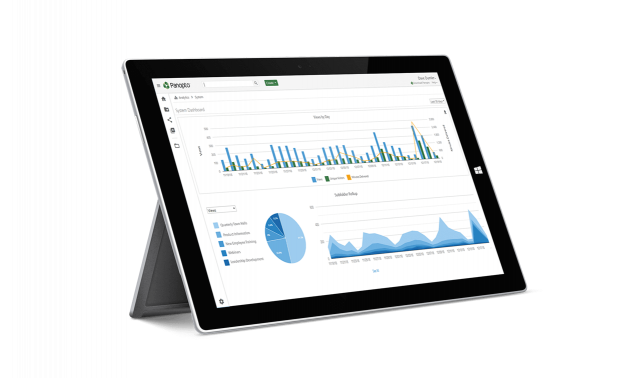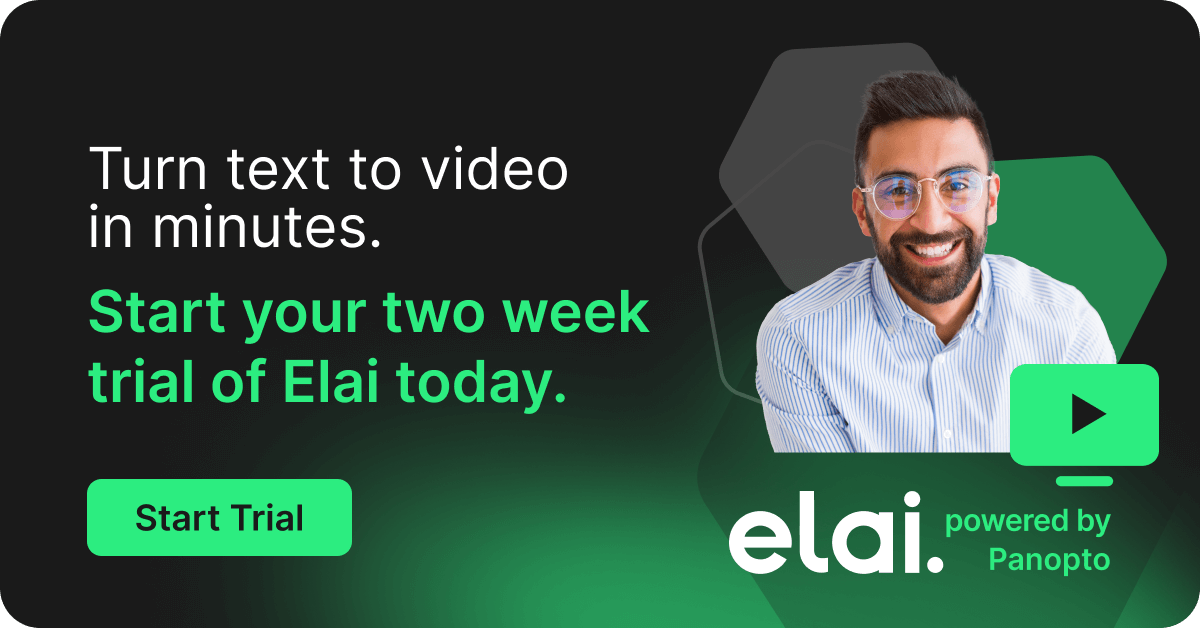- Mobile Video
Are Your Training Videos Optimized For Learning?
One of the most prominent trends in learning and development (L&D) in recent years has been a strategic shift towards just-in-time learning, or learning in the flow of work, as Bersin calls it.
Traditionally, L&D teams have been charged with designing specific organizational learning paths, then getting employees into classrooms for training sessions following those courses. Now, instead of mandating what employees need to learn, trainers are working towards enabling their people to build personalized learning experiences that may have the greatest impact on their own individual performances and careers. And rather than take people away from their work for in-person training classes, L&D teams are leveraging on-demand video-based training and flexible online courses that can be accessed at the point of need.
The top learning organizations of today are aiming to put their employees in the driver’s seat when it comes to their own learning and development. But of course, in order for this strategy to be successful, the roads must be paved and well-marked.
Learning leaders are steadily moving towards building the infrastructure that makes just-in-time learning possible and meaningful — that means designing a learning ecosystem full of on-demand training content that is both optimized for learning and easily discoverable with a simple search.
So how are they doing it?
Optimizing Training Videos For Learning
Not all training videos are created equal. Whether it’s a video recording of a live training session, a tutorial recorded by a subject matter expert, or a quick microlearning video, there are specific attributes that make some training videos more effective than others.
When the goal is to give employees the same high-quality learning experience they would get in the classroom — but in an on-demand format — the following are some of the features that L&D teams are looking to include in the video playback experience.
Multiple Video Feeds
PowerPoint slides with a voice-over simply don’t offer the same learning experience as would a more complete video that includes a recording of the trainer presenting their slides, as well as other materials like on-screen demonstrations or additional video feeds. Not only do videos like these show the learner as much detail as possible, but they also naturally include eye contact and other non-verbal cues from the presenter, all of which can be essential to engaging employees in learning.
Watch a training video recorded with Panopto:
In-Video Navigation
Without some means to navigate inside longer videos (for example, when sharing a multi-day event or an hours-long training seminar), your employees have little option but to either carve out time to watch the entire video, or to look elsewhere for a quicker answer. Neither option helps you make the best use of video as a resource for learning.
Instead, in-video navigation options like a table of contents and slide thumbnails enable employees to scan and to jump to specific topics or sections within a training video that are most relevant at the time. These capabilities can also enable microlearning without requiring your L&D team to spend time recutting longer recordings or creating entirely new videos.
In-Video Search
With just-in-time learning, employees will often already know exactly what information they are looking for. In those cases, being able to comprehensively search within a video to find the exact moment their search is mentioned will save them from hunting and pecking through a timeline — making your videos much more valuable as on-demand learning resources.
Panopto’s video learning platform automatically indexes every word spoken and shown on-screen inside a video, making it easy to search your recordings just like you might search text in a document or email. More on video search in a bit.
Variable Speed Playback
Variable speed playback enables viewers to speed up and slow down a training video to fit their learning preferences.
For lighter subjects that an employee may just want a quick introduction to, speeding up playback enables them to learn something new in as little time as possible. For more complex training topics, on the other hand, slowing down playback can enable them to comprehend new information better without having to pause and rewind over and over.
Captions
Video captions aren’t just for people with impaired hearing. In fact, one survey found that 80% of people who use closed captions have no hearing loss at all.
Adding captions to training videos can help your employees in several ways. Captions help viewers better comprehend the information presented in the video, making it easier to understand technical terms or words that aren’t spoken clearly. Video captions also improve the viewer’s focus on the content and help improve retention. And for employees whose first language isn’t English, captions make training content accessible that otherwise may not be.
Digital Notes And Bookmarks
With the ability to take notes within a training video, employees can leave notes for themselves to revisit later and create personal bookmarks at the parts that are most interesting to them. They can also download all of their notes from the video player to save elsewhere. It’s a small but mighty feature that can not only help improve retention of the information presented but also reduce the time it takes an employee to find and revisit the most important parts of a video in the future.
In-Video Quizzes
Instructors already utilize quizzing during in-class training sessions to help reinforce key concepts and improves employee engagement. Adding quizzes inside training videos similarly makes important information stick and improves employee engagement.
Mobile Device Support
Today, employees expect the flexibility to access information when they need it from wherever they are — which could be in the office on their laptops, at home on a tablet, or in the field on their smartphones.
Removing barriers to accessing and viewing interactive training content from anywhere on any device makes learning possible at the exact moment of need (or just when people’s busy schedules allow for it).
So What’s The Easiest Way To Create Learning-Optimized Training Videos?
Producing videos that are optimized for learning doesn’t have to be hard or require AV/IT support. With the right video training software, all you and your employees have to do is press record.
Panopto, for example, makes it easy to capture multi-camera training videos with just a laptop, indexes your recording for search and adds machine-generated captions to every video automatically, and even includes intuitive video editing software that also enables content creators to add in-video quizzes.
Panopto’s interactive video players are also designed to enhance the learning experience for viewers no matter what device they are using to watch. Panopto video players feature multi-camera playback that enables viewers to zoom in on a particular stream, in-video navigation and search options, variable speed playback, configurable captions, and digital notes and bookmarks.
Making Just-In-Time Learning Possible
For many organizations, the learning management system (LMS) has become the primary location where employee learning and development takes place. The only problem is, no LMS was built to truly support video-based learning.
Without a separate solution, it can be challenging to create a secure, centralized resource with all your company’s training content that can be easily searched and viewed.
Related Reading: 10 Reasons You Shouldn’t Rely On Your LMS to Manage Videos
A video content management software (or video CMS) is that solution. A video CMS not only takes the hard work out of managing video training content for L&D teams, but also to makes it easy for employees to find and watch anything in your video library with a simple search.
Here is how a video CMS helps L&D teams better support personalized on-demand video learning:
One Integrated Training Library
Most businesses today already have a collection of training videos. But these videos are often saved in a number of different places or systems, which makes it difficult for employees to watch them or even find them.
The key to enabling on-demand learning is to use a single, centralized video library that enables employees to find and stream all your training videos — just like they would find and stream a how-to video on YouTube.
A video CMS does just that. It stores all of your videos securely in one place and enables streaming on any device. And if your LMS is where your employees already go to learn, integrating a video CMS with your LMS means they can access all of your training content right within your LMS.

Advanced Video Search
Once you have all your videos in one place, employees will be able to find any training video in your library. But what if the answer to the question they have is 2 hours and 36 minutes into a 4-hour-long recording of a live classroom training session?
Even today, in most video libraries, videos can only be searched by their file name, title, or manually added tags. Even YouTube can’t search the content inside of its videos. But there is a better way.
A video CMS, like Panopto, can enable employees to find any word spoken or shown inside any video in your library with a simple keyword search, then jump to the exact spot in a video where the information they were seeking is mentioned.
Advanced inside-video search is as much a productivity tool as it is essential to enabling just-in-time learning — both for your employees, who can find what they need faster, and for your L&D teams, who no longer need to spend hours manually entering tags and other metadata for every video.
Automatic Video Transcoding & Uploading
Never waste time converting and uploading training videos again. A video CMS does this automatically. Just drag and drop video files into your video CMS and it will optimize them for playback on any device and for any kind of network connectivity and bandwidth availability.
A video CMS can also be configured to automatically upload videos from folders on your WAN, which means you can automatically capture all of your video conference recordings too.
Video Analytics
With a video CMS, you also get detailed video analytics that can inform your trainers about improvements they can make to training content, help you measure the effectiveness of your training programs, and see how specific users are engaging with your video training content. Panopto’s video CMS, for example, can show you the following:

- Which videos employees engage with the most
- Where they tend to drop off
- Viewing metrics for your entire video library
- Viewing metrics for specific folders or collections of videos
- Whether a particular employee watched a video through to completion
Start Optimizing Your Training Videos To Better Support Just-In-Time Learning
Panopto is an all-in-one-video platform for learning. Record videos that are optimized for learning simply by clicking record, upload automatically to a central, searchable video library, and enable interactive learning from videos on any device with Panopto.
To see how Panopto can support learning in your organization, contact our team today to request a free trial.




